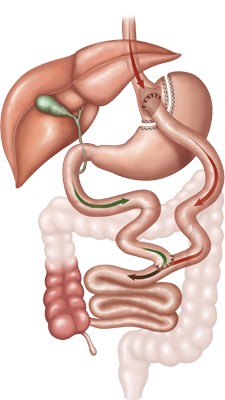
Obesity Surgery Solutions
because life is too short...
Laparoscopic Roux-en-Y Gastric Bypass
Announcements:
Bariatric Support Group Meeting
 Wednesday, July 15, 5 pm
Wednesday, July 15, 5 pmSharing experiences, recipes, supporting each other
withAndras Sandor, M.D., F.A.C.S.
Where:
ONLINE
REGISTRATION - REQUIRED
Call 781 418-1900
Obesity Surgery Information Seminar
Anytime, at your convenience
The Online Seminar is always open, call our office for a password or install the mobile app

The Roux-Y gastric bypass is the most frequently performed weight loss surgical procedure in the United States with an excellent safety profile and long term results.
In this procedure, stapling creates a small (15 to 20cc) stomach
pouch. The remainder of the stomach is not removed, but is completely
stapled shut and divided from the stomach pouch. The outlet from this
newly formed pouch empties directly into the lower portion of the
jejunum, thus bypassing calorie absorption. This is done by dividing the
small intestine just beyond the duodenum for the purpose of bringing it
up and constructing a connection with the newly formed stomach pouch.
The other end is connected into the side of the Roux limb of the
intestine creating the "Y" shape that gives the technique its name.
The length of either segment of the intestine can be increased to
produce lower or higher levels of malabsorption.
In recent years, better clinical understanding of procedures
combining restrictive and malabsorptive approaches has increased the
choices of effective weight loss surgery for thousands of patients. By
adding malabsorption, food is delayed in mixing with bile and pancreatic
juices that aid in the absorption of nutrients. The result is an early
sense of fullness, combined with a sense of satisfaction that reduces
the desire to eat.
In addition to these mechanisms, there is a
growing body of evidence pointing to substantial neurohormonal changes
following gastric bypass surgery, that directly affect metabolism,
insulin secretion and resistance, satiety and hunger. These factors
explain the terrific efficacy of gastric bypass in bringing so many
co-morbid conditions to resolution is a relatively short time period.

Real case videos of laparoscopic Roux-Y gastric bypass can be viewed
here.
According to the American Society for Bariatric Surgery and the
National Institutes of Health, Roux-en-Y gastric bypass is the current
gold standard procedure for weight loss surgery. It is one of the most
frequently performed weight loss procedures in the United States.
The surgery is performed robotically and in average, it takes about 1.0 - 1.5 hours to complete. The
average hospital stay is 1 day and most people return to work in about
2 weeks following surgery.
Advantages of Roux-Y Gastric Bypass
Rapid initial weight loss
Better results for patients with higher
BMIs
Faster resolution of certain co-morbid conditions, such as type
2 diabetes mellitus, onstructive sleep apnea, hypertension
Long
experience in the USA
“Dumping syndrome” can occur and may keep some
individuals from returning to old eating habits (beneficial for sweet
eaters)
Disadvantages
The surgery carries a higher risk since dividing and reconnecting the
stomach and the small bowel is involved
A portion of the digestive
tract is bypassed, which may result in nutritional deficiencies
Lifelong vitamin, Ca, Fe supplementation is required to prevent
deficiencies (for details, see vitamins and supplements section)
Non-adjustable
Copyright 2016 Commonwealth Weight Loss, LLC. All Rights Reserved.

